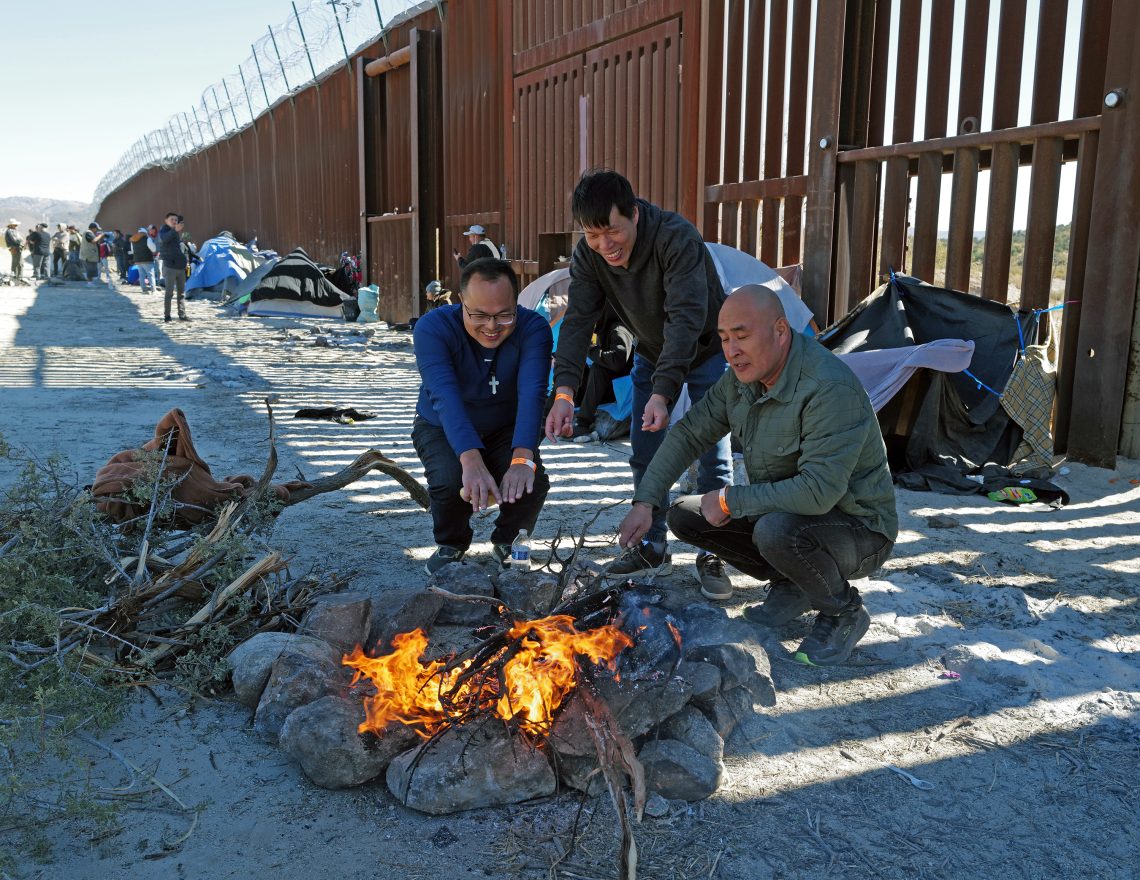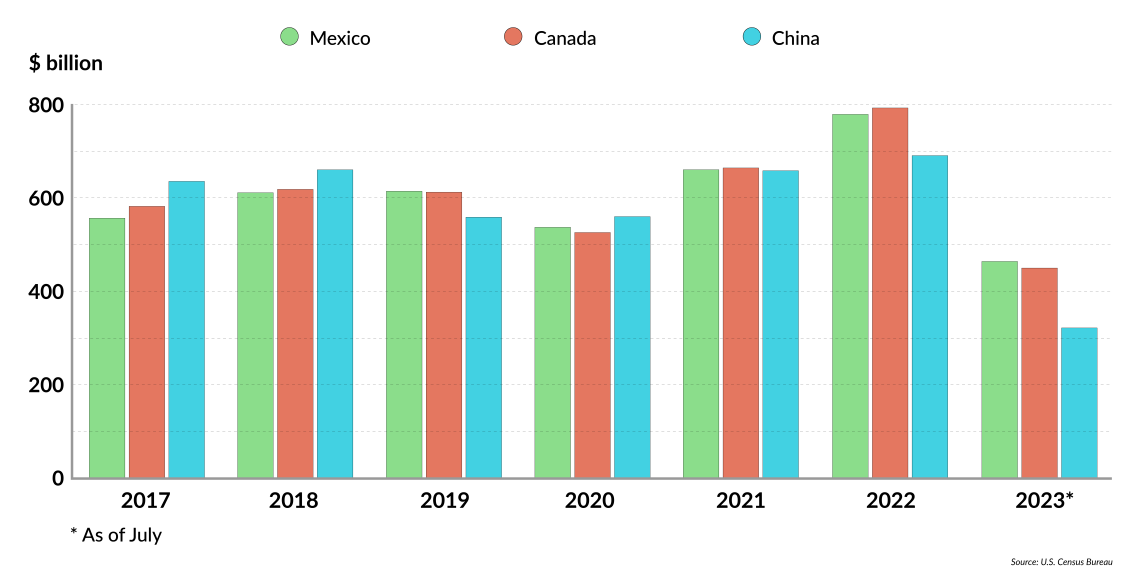U.S.-Latin American interests in freefall
If Republicans win the 2024 elections, expect Latin American policy to be focused on border security.

In a nutshell
- Both parties will focus on strengthening trade with major countries in the region
- President Biden’s failure to control the borders is becoming a major domestic issue
- The regional influence of China, Russia, Iran, Hamas and Hezbollah is rising
American interests and influence in the Western Hemisphere face almost unprecedented challenges. No aspect of United States foreign policy seems more suffused with domestic American politics. If Republicans were to win the presidency in 2024, U.S. policies would likely shift dramatically. Conversely, should President Joe Biden win reelection, the administration would probably struggle to develop sustainable policies. In either case, Latin American policy will prove uniquely challenging for the U.S., which usually does not make hemispheric relations a priority, particularly early in a presidential term.
Several issues combine to make U.S. relations with this region unusually complicated and crucial for American policymakers.
Nearshoring helps reduce dependence on China
There is strong bipartisan support in the U.S. for reducing strategic dependencies on China in supply chains and sectors like raw materials and manufacturing. Alternatives attracting greater attention are “friend-shoring,” that is, trade with like-minded friendly and dependable allies, as well as “nearshoring,” trade with countries in the region.
Canada and Mexico are already two of America’s largest trading partners. As of July 2023, Mexico tops the list, surpassing China with a volume of $462 billion in the first half of the year, with Canada in second place at $450 billion. China dipped to third place at $322 billion. It has not held the top rank since 2019. A tariff war and Covid-19 took their toll on bilateral trade. As for Mexico, the increase was largely triggered by a rise in manufacturing key components of goods.
The current administration is promoting increased trade with other Latin American countries as well, specifically stating a goal of unseating China’s global dominance in manufacturing. Recently, the administration undertook its first Americas Partnership for Economic Prosperity Leaders’ Summit in Washington, D.C.
There are, however, significant challenges in expanding markets, including chronic issues with corruption, rule of law, human resources and political stability. According to Transparency International, levels of corruption have recently continued to increase across Latin America and the Caribbean. In addition, China is also seeking to expand trade with Latin America, including investing in manufacturing and national infrastructure.
More by James Jay Carafano
War in Israel casts doubt on U.S. Middle East policy
The ebb and flow of the Three Seas Initiative
Tensions rise in U.S. civil-military relations
A surge in illegal migration changes everything
Illegal migration remains a greatly disruptive force. As a result of U.S. administration policies, an estimated 1.5 million illegal migrants entered the U.S. in the first half of 2023. The numbers of illegal migrants have consistently grown throughout Mr. Biden’s presidency.
Across Latin America, migration has both positive and negative impacts. On one hand, remittances from migrants to their home countries are an important source of revenue. In 2022, remittances to Latin America reached unprecedented levels, exceeding $145 billion. About half of all remittances go to Mexico. On the other hand, migration also affects countries’ populations, transnational crime and domestic politics. Human trafficking is on the rise and has become one of the most profitable criminal activities in Latin America. Profits from human trafficking and illegal migration fuel other forms of transnational criminal activities. Transnational gangs and cartel influence have increased in the region.
Latin America has become a hub for global human trafficking. For instance, migrants from Africa, Asia and the Middle East use Venezuela as a point of entry in the Western Hemisphere for illegal migration to the U.S.
Administration policies have exacerbated these challenges. President Biden has stated as part of the policy to establish orderly and regular migration, that his administration would address the “root causes” of illegal migration. He appointed Vice President Kamala Harris to lead this effort. Yet, well into his presidency, administration policies have had no discernable salutary impact on managing migration.
U.S. regional policies have exacerbated challenges. The most well-known is the administration canceling the “remain in Mexico” policy which proved a significant deterrent to abuse of asylum claims. There are, however, many other policies that have adversely impacted efforts to address the disruptive impact of illegal migration. For instance, Guatemala offered Washington a comprehensive deal on managing border migration, which the Biden administration rebuffed. Recently, the U.S. offered sanctions relief to Venezuela in exchange for promises of free and fair national elections, effectively ignoring the increasingly prominent role the Caracas regime plays in global human trafficking.
In recent polls, immigration, Mr. Biden’s age and the economy emerged as the top three issues of concern with the president’s reelection. In addition, multiple recent polls show the president losing support among Hispanic voters.
Facts & figures
Mexico and Canada are the top trade partners of the United States

Biden’s political goals out of alignment with many in Latin America
The president has emphasized foreign policy priorities that coincide with his domestic agenda. In particular, the White House focuses on climate change, the green energy transition, gender issues and reproductive rights. Developing economies in Latin America are more concerned about growth and employment than climate and renewable energy policies. In addition, many Latin American nations are socially conservative and less appreciative of U.S. initiatives in these areas. Some countries have seen an increase in anti-American attitudes. Recently, for instance, a group of Brazilian parliamentarians penned a letter to the U.S. Congress complaining of administration policies.
The Biden administration, a progressive center-left government, also shows more preference for leftist regimes in Latin America. The administration, for instance, returned to the Obama-era policy of normalizing relations with Cuba. In addition to moving to improve relations with Venezuela, Washington has sought stronger ties with new leftist governments in Brazil and Colombia. On the other hand, it has taken a harder position with center-right governments, such as Guatemala, quicker to label these regimes autocratic and anti-democratic.
Many of the regimes the Biden administration favors, however, are pro-China, pro-Iran, pro-Russia and are often guilty of human rights and civil rights abuses. Leaders of several of these nations, including Cuba, Venezuela, Bolivia, Colombia and Brazil, align with the Sao Paulo Forum, which brings together far-left and communist parties from across the region in an attempt to counteract free-market capitalism. There is no question the expansion of the forum’s influence will conflict with U.S. interests and sway in the region.
China, Russia and others gain strength in Latin America
The impact of non-regional powers in Latin America is more significant now than at any period since the Cold War. China, Russia, Iran, Hamas and Hezbollah, for instance, all have a significant presence and influence in the region, and they all have policies antithetical to core U.S. interests. Of late, there is additional concern about the increased possibility of transnational terrorism, which could be state-sponsored, directed at the U.S. through Latin America. Competing with external powers in the Western Hemisphere creates additional challenges for the U.S.
Scenarios
The most likely scenario is for significant shifts in U.S. policy if the party that controls the White House changes hands in 2025. The most striking shifts will be in immigration and border security, where a Republican administration would put much more emphasis on enforcement and joint regional cooperation.
Regardless of the outcome of the elections, American policymakers will be challenged to develop effective, comprehensive policies that address all vital interests in Latin America. Exacerbating this challenge is the increasing divide between the political right and left across the region.
U.S. policy under either a Republican or Democratic administration will likely focus on the most strategically important countries. These will include Mexico, Venezuela, Brazil and Colombia.
Shocks could significantly alter the challenge of implementing comprehensive policies. These could include a global recession which would significantly impact the regional economy and affect migration pressures; a major 9/11-style terrorist attack; a regional insurgency or efforts by foreign powers to establish military bases in Latin America, affecting the population, transnational crime and domestic politics of various countries.
For industry-specific scenarios and bespoke geopolitical intelligence, contact us and we will provide you with more information about our advisory services.








